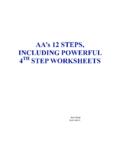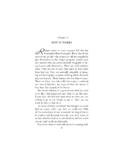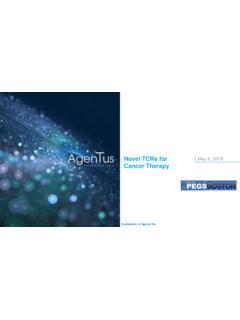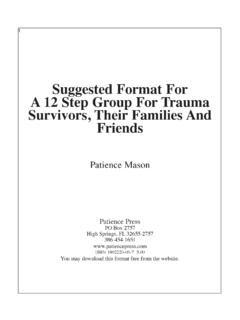Transcription of 1. Accept that addiction is a chronic disease that is ...
1 2131. Accept that addiction is a chronic disease that is cunning , baffling and powerful . For generations addiction was understood to be a lack of believed that the addicted person chose to make bad decisionsand act selfishly. People thought recovery could be accomplished by forcingaddicts to take responsibility for their actions and say no to their urges recent decades, science has discovered that addiction is a complex dis-ease, influencing brain function on various levels. Biochemical responsesand DNA abnormalities are among the many factors that may contribute to addiction . Since these factors impact a person physiologically (bodychemistry) and psychologically (mind and emotions), treating addiction isfar more involved than simply expecting alcoholics/addicts to take responsi-bility for their actions and say no to urges (see ).
2 Accepting responsibility is important. However, more is required. The diseased brain of the alcoholic/addict needs time to detox and begin toheal. They need to be educated about the disease of addiction and learnskills to work through the consequences caused by drinking/using, as wellas skills to help them live life differently. AA literature describes this diseaseas being cunning , baffling and powerful . Once a person s brain is altered byaddiction, they must remain constantly on guard to avoid addicted person needs to make tough decisions and apply a disciplinedeffort to break free from using alcohol or drugs. However, this step in theirrecovery can be very difficult because they have a brain disease that canoverwhelm good judgment and hijack their will.
3 Recovery demands a constant, dedicated effort to combat a chronic , life-threatening is a chronic disease which impairs the mind s ability to make good choices. Common symptoms are denial, minimization and Recognize the signs of line between substance abuse and addiction is often hard to seeuntil it has been crossed. An individual may deny they have an addic-tion until the consequences are overwhelming and undeniable: a lost job,broken relationships, a DUI, financial problems, legal issues, or a serioushealth CAGE Test is one way to think about whether you or someone you know has an addiction . (Score 1 point for each yes answer.)
4 You ever felt you should Cut down your use of drugs or alcohol? you ever been Annoyed when people have commented on your use? you ever felt Guilty or badly about your use? you ever used drugs or alcohol to Ease withdrawal symptoms, or to avoid feeling low after using?If you scored 1, there is an 80% chance of you scored 2, there is an 89% chance of you scored 3, there is a 99% chance of addictionIf you scored 4, there is a 100% chance you are addicted to drugs or Identify the factors that contribute to your addiction and find drink and use drugs for a reason. They want to feel different. Part of effective addiction treatment requires discovering the uniquefactors that contributed to each person s is a reason why alcoholics/addicts start to drink or use.
5 For many ofthem that reason is hazy when they first enter treatment. As they detox and their brains begin to heal, they are able to make the connection be-tween life events and their pattern of drinking/using. They see that therewere underlying contributing factors that caused them to startdrinking/using, and often there were additional life events that escalatedthe problem, causing them to drink/ use more. Often they realize that theyused their drug of choice to self-medicate and relieve a physical level we find that some alcoholics/addicts drink/use to combat fatigue or exhaustion that has become a chronic problem, prevent-ing them from doing their job effectively or having enough time to spendwith family members.
6 Others suffer from chronic illness or physical pain,and they start to drink/use to cope with their physical might rationalize this problematic behavior, telling themselves it s oksince the medications were prescribed by a doctor. On a mental level we4find that some alcoholics/addicts are depressed and they drink or use tohelp lift their mood. Others struggle with anxiety due to mental may be troubled by constant internal conflict or racing thoughts thatprevent their minds from resting. They find that drugs quiet their mind, reducing the constant chatter or negative thought patterns or past memories that are intruding into the present moment.
7 Alcohol or drugsmight let them experience some peace and quiet during the day, and help them sleep at night. Repeated use of addictive substances builds tolerance, causing a person to need more and more in order to get the same relief. Many people struggle on an emotional level because they ve never beentaught to acknowledge their emotions and manage them in healthy people develop a pattern of suppressing them and find that over timethe stored emotions have become so vast and intense that they need thehelp of alcohol or drugs to continue to effectively suppress them. Othersdrink or use to summon the courage to say or do what needs to be said ordone.
8 Some people have suffered from emotional wounding that resultedfrom divorce, death, abuse or neglect. If they have never dealt successfullywith the underlying issues, they may be using alcohol or drugs to bury theiremotional a spiritual level there may be underlying factors such as: spiritual empti-ness resulting from a lack of knowledge about God, religion or spirituality;anger or hostility toward God because of certain life events; or spiritualwounds resulting from a religious experience that presented a distortedview of faith and spirituality. Like other areas of concern, spiritual issues area source of profound pain and contribute to patterns of there are underlying factors that contribute to drinking/using.
9 On a social level these factors are often related to shyness, feelings that youdon t belong or fit in, or perhaps an intense level of social anxiety. In a social context there may be problems bonding with others or participatingin effective communication, or there may be difficulty solving problems,making decisions, or resolving these situations, people drink/use to self-medicate. Socially, some peoplebecome addicted simply because they are curious and na ve, thinking they ll just experiment with alcohol or drugs without any appreciation ofhow powerfully addicting these substances can be. These people may try an addictive substance because of peer pressure or a desire to fit in or to be popular.
10 Depending on the drug and the genetic predisposition of theperson, they may find themselves rapidly addicted to the euphoric highthey the underlying issue, it needs to be identified and healed becausethey exert a powerful force that contributes to patterns of drinking/using. Until they are addressed and cleared, they will cause an alcoholic/addict tocontinue to drink/use, or to be at risk for is sneaky. It is often described as a sleeping tiger, waiting for the right situation to wake up and push someone toward addiction or Seek effective treatment at a facility that meets the needs of the any chronic disease , addiction needs to be treated.




